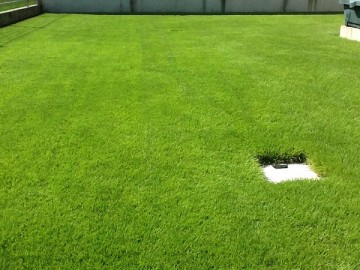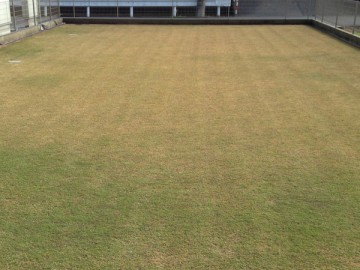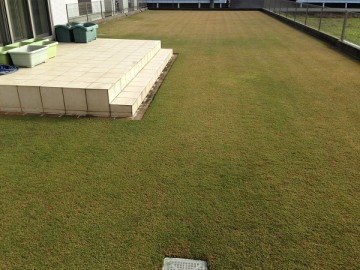The Reason Why We Chose TM9
2016/01/05
As I wrote before, we built our new home and planted Korai-Shiba (Zoysiagrass) in our backyard in 2010 and then replaced it to a low-maintenance Korai-Shiba, TM9, in 2013. Though it is a personal experience, I will write the reason why we replaced the lawn with TM9.

The above photo is the area of about 68 m2, where lawn was originally planted since when we built our new home in 2010.

The lawn looked like the above photo in those days. The grass is a common Korai-Shiba and fairly long. (The position of the rainwater pit is different from the current position.)

Then we expanded the lawn area and added the area of about 166 m2 in the above photo in 2013.

It’s got about 234 m2 in total, roughly 3.4 times the area of the original.
I didn’t have any complaints about the original Korai-Shiba but liked it so much; however, I thought that I had no choice but to replace the lawn with TM9 when I expanded it, because too much cut grass is accumulated after mowing in case of common Korai-Shiba.
In common Korai-Shiba, usually 2 to 3 bags, sometimes 5 bags maximum, of cut grass is accumulated for 45-L garbage bag designated by the city, after each every 1 to 2 weeks of mowing, from roughly 68 m2 of the lawn. Though it was still acceptable those days, if the area of the same Korai-shiba becomes 3.4 times, the cut grass will also become 3.4 times, i.e., for 17 garbage bags. It’s too much. So I replaced the lawn with TM9 when I expanded it.
TM9 is a low-maintenance Korai-Shiba developed by Toyota Motor. A distributor company website writes that “the grass height is less than half the existing cultivars, so mowing frequency can be greatly reduced”. The reduction of the mowing frequency is not necessary for me, because I like the mowing. But, the cut grass at each mowing is reduced if the growth is slow. (I understand that, the tall grass height means the fast upward growing speed, and the low grass height means the slow upward growing speed.)
It’s been about 2 years (as of 2015) after expanding lawn and planting TM9, the cut grass at each mowing is about 6 garbage bags at most though I haven’t counted correctly. It’s less than one third of the common Korai-shiba in calculation. TM9 was the right choice.
Though this story is just one example, in our home, It hope it helps who’s planning to plant a lawn and still thinking which type of lawn to choose, between common Korai-shiba and TM9.

